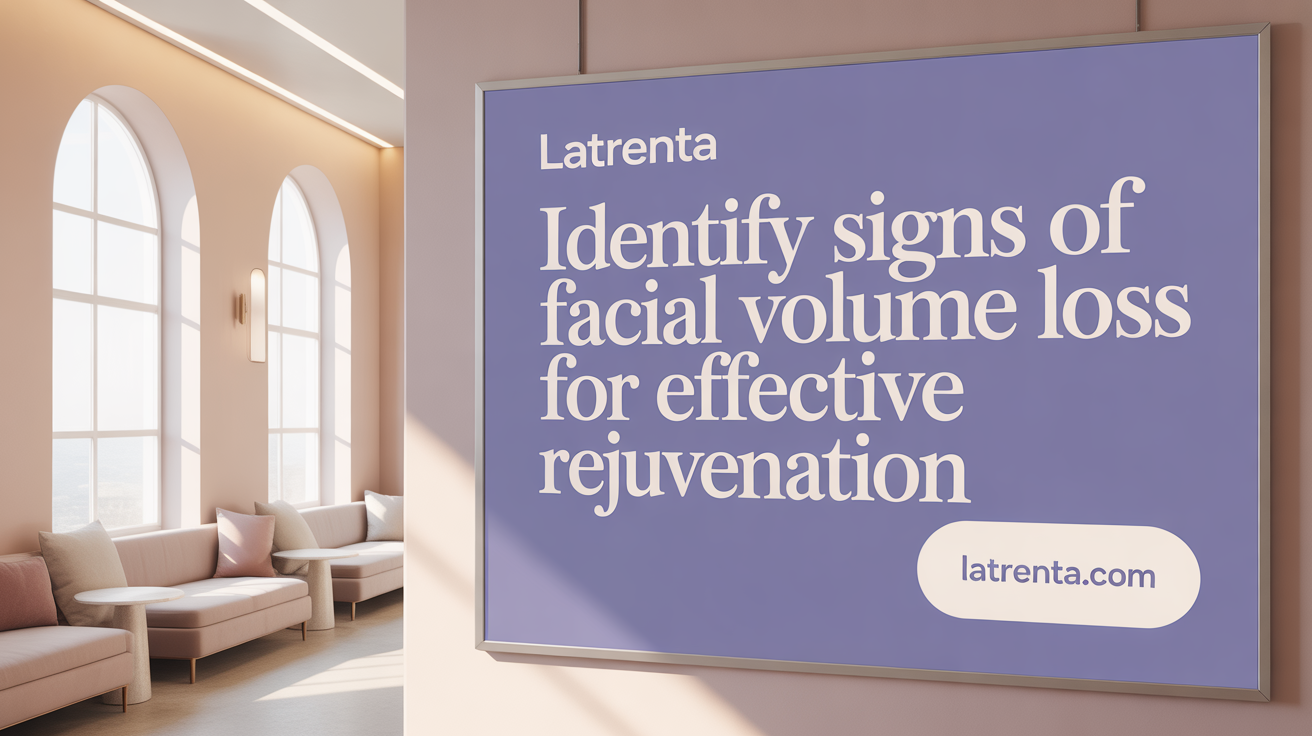Understanding Facial Volume Loss Post-Weight Loss
Significant or rapid weight loss often brings visible changes beyond shifts on the scale, including noticeable facial volume loss. This condition leads to hollow cheeks, sagging skin, and deep wrinkles, creating an aged or gaunt appearance. Understanding the causes, signs, and treatment options for facial volume loss is essential for those seeking to restore a youthful, vibrant look after weight loss.
Causes and Signs of Facial Volume Loss After Weight Loss

What causes facial volume loss after weight loss?
Facial volume loss after weight loss primarily occurs when the fat pads under the skin diminish. Rapid or significant weight loss leads to the reduction of subcutaneous facial fat, especially in areas like the cheeks, temples, and jawline.
In addition to fat loss, aging plays a crucial role. As we age, collagen and elastin production decline, and bones gradually lose density, resulting in less structural support for the face.
Environmental factors such as sun exposure and lifestyle choices like smoking can accelerate skin aging, which further exacerbates volume loss.
Medications like Ozempic (semaglutide), used for weight management, are also associated with facial volume depletion. They promote fat loss in the face, leading to a sunken appearance, increased skin laxity, and an aged look.
What are the typical signs of facial volume loss?
Signs of facial volume loss are quite noticeable and include:
- Hollow cheeks and temples
- Sagging skin or jowls along the jawline
- Deep folds such as nasolabial folds and marionette lines
- Sunken under-eye areas
- Fine lines and wrinkles that become more prominent
- Overall, a gaunt or hollow appearance giving an aged look
These signs result from the loss of fat, collagen, and bone support that keeps the face looking firm and youthful.
How do medications like Ozempic contribute to facial volume loss?
While Ozempic effectively aids weight loss, it can also lead to unintended facial consequences. The reduction in facial fat caused by Ozempic contributes to a sunken look, especially in the midface, temples, and jawline.
Patients on Ozempic might notice a gaunt or hollow appearance, alongside increased sagging of the skin. This occurs because the rapid reduction in facial fat often surpasses the skin’s ability to adapt, making these changes more pronounced.
Understanding these effects is important when considering treatment options for facial rejuvenation after weight loss or medication-induced volume loss.
Non-Surgical Treatments to Restore Facial Volume and Skin Quality

How do dermal fillers work to restore lost volume?
Dermal fillers, especially hyaluronic acid-based products like Juvederm and Restylane, are injected into areas such as cheeks, lips, and the jawline. They provide immediate plumping of sunken or hollow areas, helping to restore youthful facial contours. These fillers are biocompatible, reversible, and typically require minimal downtime. The effects usually last from six months to over a year, depending on the specific product used and individual factors.
What are biostimulatory injectables and their benefits?
Biostimulatory injectables like Sculptra® (Poly-L-lactic acid) and Radiesse® (calcium hydroxylapatite microspheres) work by stimulating the body's natural collagen production. Over time, this leads to gradual volume restoration, improved skin firmness, and better texture. These treatments are especially effective for deep lines, hollowing, and generalized facial thinning, providing results that can last for over two years. They support long-term skin health and help address age-related changes more naturally.
How do microneedling and laser therapies support volume restoration and skin quality?
Microneedling creates tiny punctures in the skin to stimulate collagen and elastin production. When combined with platelet-rich plasma (PRP), the regenerative effects are amplified, leading to enhanced skin firmness, tone, and elasticity. Laser treatments, such as fractional lasers or skin resurfacing, help tighten loose skin, improve texture, and promote collagen growth. These modalities complement filler and injectable treatments by addressing skin quality, making the overall rejuvenation more natural and lasting.
What improvements do these treatments offer in terms of skin texture and natural contours?
Together, these treatments improve skin texture by reducing fine lines, evening skin tone, and enhancing overall firmness. They support and refine natural facial contours by restoring volume, lifting sagging areas, and smoothing wrinkles. The combined effect results in a more youthful, balanced appearance with a natural look, avoiding the overly artificial appearance sometimes associated with surgical procedures. Regular maintenance and a good skincare routine further enhance and prolong these results.
| Treatment Type | Duration of Results | Main Benefits | Suitable For |
|---|---|---|---|
| Hyaluronic Acid Fillers | 6 months to 2 years | Immediate volume, minimal downtime | Sunken cheeks, lips, jawline, under-eye hollows |
| Sculptra and Radiesse | Over 2 years | Collagen stimulation, natural long-term volume | Deep lines, hollowing, skin laxity |
| Microneedling with PRP | Several months, repeat sessions needed | Improved skin texture, tone, and firmness | Fine lines, loose skin, dull skin |
| Laser Resurfacing | Weeks to months | Skin tightening, texture improvement | Sun damage, uneven skin, scars |
Targeting facial volume loss through non-surgical methods not only restores youthful contours but also enhances skin quality. These treatments, especially when combined, offer a comprehensive approach to facial rejuvenation, helping individuals achieve natural-looking results with minimal recovery time.
Dermal Fillers and Their Role in Reversing Volume Loss, Including Medication-Related Changes

How do dermal fillers address sunken cheeks and facial hollows?
Facial volume loss often leads to hollow cheeks, sunken temples, and a loss of youthful contours. Dermal fillers, especially those based on hyaluronic acid, are widely used to restore lost volume in these areas.
By injecting fillers beneath the skin, practitioners can plump up hollow regions, lift sagging skin, and create smoother, more defined facial contours. This non-surgical procedure is effective in enhancing facial balance, diminishing wrinkles, and improving overall appearance. The immediate effect of fillers provides a natural, youthful look, making it a popular choice for those wanting quick results.
The treatment targets key areas such as the cheeks, under-eye hollows, and the jawline, addressing both aesthetic concerns and age-related changes caused by volume depletion.
What types of fillers are used and their lasting effects?
There are several types of dermal fillers used for facial volume restoration:
| Filler Type | Composition | Duration | Best For |
|---|---|---|---|
| Hyaluronic Acid (e.g., Juvederm, Restylane) | Hyaluronic acid, a natural carbohydrate | 6 months to 2 years | Cheeks, lips, under-eye hollows |
| Calcium Hydroxylapatite (Radiesse) | Mineral-like compound | About 1 year | Deep wrinkles, contouring |
| Poly-L-lactic Acid (Sculptra) | Collagen stimulator | Over 2 years | Generalized volume loss, deep lines |
Hyaluronic acid fillers are reversible and provide immediate results, making them a flexible option. Sculptra stimulates collagen production gradually, offering long-term improvement.
How do fillers help patients experiencing volume loss from medications like Ozempic?
Medications like Ozempic, used for diabetes and weight management, can cause rapid facial fat depletion, leading to an aged and hollow appearance—sometimes called "Ozempic face." Dermal fillers come into play as an effective, minimally invasive solution to counteract these changes. They help restore the volume lost in the mid-face, temples, and jawline, improving facial contours and reducing signs of aging.
Fillers filled with hyaluronic acid replenish depleted fat pads, soften deep wrinkles, and lift sagging skin. This results in a more youthful, balanced appearance with immediate effects and minimal recovery time. It makes fillers an attractive option for patients seeking non-surgical rejuvenation after medication-induced volume loss.
Who are the ideal candidates for dermal filler treatments?
Anyone experiencing facial volume loss due to aging, weight loss, or medication effects like Ozempic can consider dermal fillers. Ideal candidates are those with reasonable expectations, good overall health, and realistic goals of enhancement rather than drastic change.
Candidates should have healthy skin and be free from active skin infections or certain allergies. Consultation with a qualified practitioner helps determine the most suitable type of filler and treatment plan tailored to individual facial anatomy and concerns.
In summary, dermal fillers serve as a versatile, effective method to restore facial volume, improve contours, and achieve a refreshed appearance without surgery. Their ability to address changes caused by medications such as Ozempic underscores their importance in modern facial rejuvenation strategies.
Fat Transfer, Thread Lifting, and Surgical Options for Durable Facial Volume Restoration
What treatment options are available to regain facial volume after major weight loss?
When facial volume diminishes significantly following weight loss, several effective solutions can help restore a youthful, full appearance. Non-surgical options like dermal fillers, such as hyaluronic acid formulations, are popular for immediate volume enhancement in areas like cheeks, under the eyes, and jawline. These treatments provide quick results with minimal downtime.
Beyond fillers, facial fat transfer stands out as a long-lasting, natural alternative. This procedure involves harvesting fat from other parts of the body, typically the abdomen or thighs, through liposuction. The extracted fat is then purified and reinjected into sunken facial zones to recreate volume and contours. The results are natural-looking and can last many years, offering an appealing solution for those seeking a permanent fix.
In cases of more pronounced sagging and excess skin, surgical procedures like facelifts or mini-lifts are often recommended. These surgeries involve lifting and tightening loose skin, restoring a more youthful contour and addressing severe aging signs.
How do thread lifts complement volume restoration?
Thread lifting is a minimally invasive procedure that uses absorbable threads inserted under the skin to lift sagging areas. Besides providing a subtle lift, these threads stimulate collagen production, which improves skin firmness and texture over time.
When combined with volume restoration treatments such as fillers or fat grafting, thread lifts can enhance overall facial rejuvenation. They help reposition and support facial tissues, resulting in a more defined, lifted appearance. This combination is particularly beneficial for patients who desire moderate lifting without undergoing full surgery.
When is surgery, such as facelifts or mini lifts, recommended?
Surgical options like facelifts or mini-lifts are best suited for individuals experiencing substantial skin laxity and significant sagging, especially in the jowls, neck, or midface. These procedures provide a more definitive correction by removing excess skin and tightening underlying tissues.
The long-term effects of surgical lifting often last over ten years, making them an excellent choice for patients with advanced aging signs or those who have undergone severe weight loss.
How can combination treatments optimize facial rejuvenation?
Combining various treatments allows for a comprehensive approach tailored to each person's needs. For instance, a patient might undergo a fat transfer to restore volume, followed by RF microneedling or laser therapy to tighten skin and improve texture. Adding thread lifts and fillers can further enhance contours and address specific areas.
This multimodal strategy maximizes natural results, prolongs benefits, and minimizes risks associated with isolated treatments. Overall, combining surgical and non-surgical options offers a personalized pathway to restoring facial harmony and youthful vitality after weight loss.
| Treatment Type | Typical Duration | Main Benefits | Suitable For |
|---|---|---|---|
| Dermal Fillers | Several months to 2 years | Immediate volume increase, minimal downtime | Mild to moderate volume loss |
| Fat Transfer | Permanent | Natural appearance, long-lasting | Significant volume loss |
| Thread Lift | 1–2 years | Lifts sagging tissue, stimulates collagen | Mild to moderate sagging |
| Facelift/Mini-lift | Over 10 years | Long-term tightening, contour correction | Severe sagging |
| Combination Treatments | Varies | Enhanced, natural outcomes | Complex cases with multiple concerns |
By evaluating individual needs, a skilled specialist can craft a personalized treatment plan that combines these options effectively, ensuring optimal facial rejuvenation after weight loss.
Expert Guidance and Preventative Care for Long-Term Facial Volume Maintenance
When considering treatments to restore facial volume after significant weight loss, expert advice emphasizes a personalized approach. A thorough consultation with a board-certified dermatologist or aesthetic specialist is crucial to evaluate factors such as the extent of volume loss, skin elasticity, facial structure, and overall skin health. This helps identify the most suitable options—whether immediate-volume fillers like hyaluronic acid-based products, collagen-stimulating injectables like Sculptra, or longer-term solutions such as facial fat transfer.
Aesthetic professionals also advise setting realistic expectations. Treatments can significantly improve facial contours and reduce signs of aging, but the underlying process of natural aging—including declines in collagen, elastin, and bone density—continues over time. Lifestyle choices greatly influence treatment outcomes; habits like sun exposure, smoking, and poor diet can accelerate skin aging and volume loss. Adopting healthy habits can enhance and prolong the effects of rejuvenation procedures.
Alongside procedural treatments, maintaining skin health through diligent skincare routines is vital. Using medical-grade products containing retinol, hyaluronic acid, peptides, and broad-spectrum SPF protects skin from environmental damage and supports collagen production. Regular practices such as resistance training, staying well-hydrated, and eating a balanced, nutrient-rich diet contribute to preserving facial volume and skin firmness.
For optimal long-term results, experts often recommend combining multiple approaches—like dermal fillers for immediate correction, biostimulatory injectables for ongoing collagen synthesis, and skin tightening lasers or RF microneedling to improve skin tone and elasticity. Such combination therapies can be tailored to individual needs, age, and skin condition.
Preparation for treatment involves avoiding sunburns, quitting smoking, and adhering to recommended skin care regimens. Post-treatment, caring for skin includes maintaining hydration, avoiding excessive sun exposure, and using soothing skincare products to support skin recovery. Regular follow-up visits ensure the longevity of results and allow adjustments to treatment plans as skin and facial features evolve.
Restoring Confidence Through Personalized Facial Volume Treatments
Facial volume loss after weight loss can significantly impact one’s appearance and self-esteem, but numerous effective treatments are available to rejuvenate and restore youthful contours. From immediate improvements with hyaluronic acid fillers to long-term solutions like fat transfer and surgical lifts, options can be personalized to fit individual needs and goals. Complementary skin tightening and collagen-stimulating treatments further enhance outcomes, improving texture, firmness, and skin quality. Expert guidance in selecting and combining therapies, along with preventative skincare and lifestyle habits, ensures sustainable rejuvenation. Embracing these treatments empowers individuals to regain a fuller, healthier facial appearance and renewed confidence after weight loss.
References
- How to Treat Facial Volume Loss Due to Weight Loss
- 5 Treatments to Restore Lost Facial Volume
- Facial Volume Loss and How You Can Restore It | SkinCeuticals
- Facial Volume Loss After Weight Loss: The Best Treatments for a ...
- Weight Loss and Facial Volume Loss: What You Need to Know
- The Best Treatments for Facial Volume Loss After Weight Loss
- Treatments to Restore Facial Volume After Weight Loss
